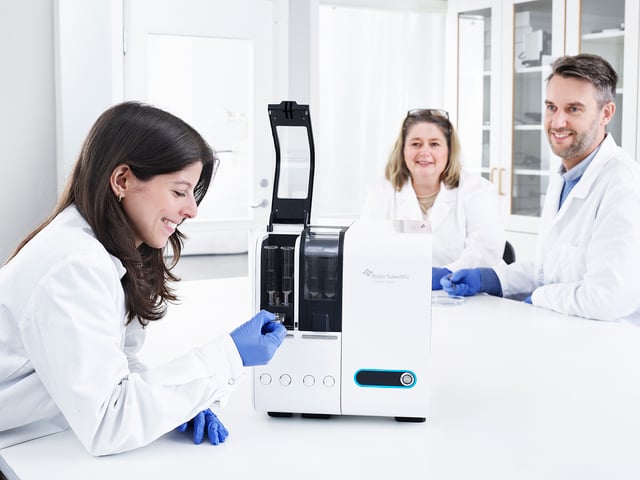
Investment in an advanced piece of scientific equipment, such as a QCM-D instrument, can be a success factor for science and innovation. There can, however, be uncertainties regarding what instrument configuration and capabilities that will be needed long-term to support the scientific work and project paths that are yet unknown. To lower the investment barrier and enable more users to benefit from the QCM-D technology, we developed QSense Omni, our 4th generation QCM-D platform which is a modular and upgradeable instrument suite that allows scientists to grow with their research.
An investment in a piece of advanced scientific equipment, such as QSense QCM-D, is most likely made with the vision that the instrument will contribute with valuable information for many years to come. Depending on the scientific field or industrial area, however, the ability to predict the future needs in terms of hardware configurations and capabilities can be a challenge. Depending on the scientific field, or research area, and structure of the organization, the hardware configuration needs may change as the scientific field evolves, the research takes on a different direction, or the need of throughput increases. At the same time, there is a driver for research to be more and more interdisciplinary in both universities, research institutes, and in commercial laboratories [1]
One way to secure the long-term usability of the QCM-D setup is of course to invest in the best possible, most advanced instrument configuration, from the start, i.e., aim for the widest specification and include all accessories available to maximize capacity in terms of throughput and capabilities. As the price tag of this configuration will be high though, this approach can be unnecessarily expensive. There is also a risk of over-investment, i.e., investing in more instrument capacity than the long-term need demands.
Another approach to secure that the future equipment-needs are met, while at the same time minimizing the cost of investment and eliminating the risk of over-investment, is for us as instrument supplier to design a versatile, and upgradable platform, i.e., to offer a modular QCM-D platform where the setup configurations are based on current user needs. This could be based on an entry-level configuration which can be expanded with additional capacity in terms of throughput and expanded specification and configuration whereafter the user needs arise, if they arise.
With the ambition to provide QCM-D instrumentation which delivers value for many, many years to come, we designed a modular platform, offering maximal automation and performance even if the user chooses to start with the base configuration, while at the same time having wide-ranging possibilities to expand both throughput and adding on versatility which will meet the unique needs to measure at a broad range of conditions.
Compatible QSense modules:
Investment in cutting-edge scientific equipment, such as a QCM-D instrument, can significantly contribute to the success of scientific research and foster innovation. However, uncertainties regarding the long-term needs of the instrument in supporting scientific efforts and potential projects that are yet to be explored may impede investment; the hardware configuration requirements could evolve over time based on the scientific field, research direction, organizational structure, and the increasing demand for throughput. To overcome this challenge and enable more users to benefit from the QCM-D technology, we developed QSense 4th generation QCM-D, a modular and versatile platform, with possibilities to upgrade or add-on additional capabilities as the needs arise, if they arise.
Download the technical whitepaper to learn more about QSense Omni features and design.
Compared to QCM, QCM-D measures an additional parameter, and provides more information about the system under study.
Discover how QCM-D analysis reveals real-time etching dynamics, helping optimize cleaning processes and protect surfaces from unwanted damage.
Discover how QSense QCM-D helps tackle fouling challenges across industries
Discover how QCM-D enables real-time, label-free analysis of supported lipid membrane formation, structure, and dynamics for advanced research
Learn how QSense QCM-D analysis can reveal membrane fouling dynamics and optimize cleaning strategies for more efficient water treatment
Learn how QSense QCM-D helps detect and prevent surface-induced instabilities in biologics. Join our webinar for insights and practical examples.
Learn about the top QSense sensors for analyzing biopharmaceutical drug-surface interactions in the context of IV bags.
Learn about QCM-D, Quartz Crystal Microbalance with Dissipation monitoring - an analytical tool for surface interaction studies at the nanoscale.
Explore QSense QCM-D sensors to optimize cleaning efficiency with real-time insights, enhancing formulations and protocols across various conditions.
Jennie Ringberg is a former employee at Biolin Scientific. She was the Global Technical Product Manager for QSense and also held roles as Application Specialist for QSense, In-House Sales Manager, and Academy Manager. Jennie holds a Master of Science in Bioengineering from Chalmers University of Technology and spent the first years after graduation focusing on membrane proteins and how to identify and characterize these in the best way.
